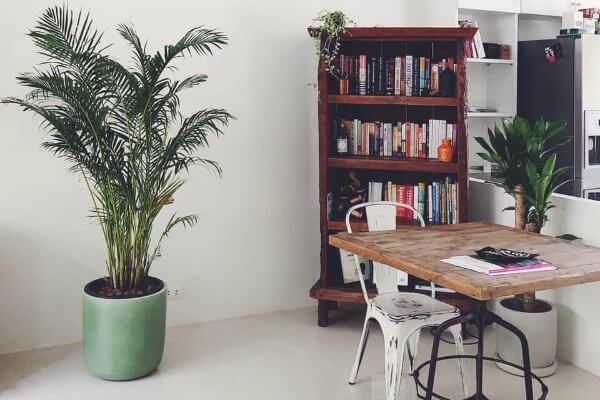Overview
The Areca Palm (Dypsis lutescens) is native to Madagascar. The Areca Palm is one of the most popular houseplant palms because it is easy to grow and effective in purifying the air. With a smooth silver green trunk, the Areca Palm is topped by feathery fronds. These fronds grow in clusters with approximately six to eight leaves, on long curving upward petioles. Areca Palms grow approximately 15 to 25 cm annually until they reach their maturity at about 2-3 meters tall, however, expect slower growth rate when potted.

Light and Water
Light: Areca Palms require bright indirect sunlight throughout the day and can even tolerate some direct sunlight, areca palm will naturally turn slightly yellowish when grown in prolonged hours of direct sunlight condition. Place the Areca palm next to a west or south facing window for best growth. However, they can withstand full sun condition when placed together with multiple plants and sufficient watering.
Water: Areca Palms require moist soil but not soggy that it’s drowning. During the first month, you may need to check your plant daily to work out your watering routine for the areca palm. Strive for moist soil but not soggy and your plant will thrive. Always provide thorough watering by pouring in enough water until it runs out of the pot’s drainage holes. Usually water once or twice a week for indoor areca palm to maintain moist soil.

Temperature and Humidity
Temperature: For indoor growing conditions, areca palms thrive in temperatures range between 16°C – 28ºC. Keep up with your watering routine and make sure soil is always moist if grown outdoor sunny conditions.
Humidity: Average humidity of 40-60% is perfect, having humidifying in the room can be beneficial to the palm.
Soil and Fertilizer
Soil: Well draining potting mix is recommended to avoid soggy soil which causes root rot.
Fertilizer: Apply a tablespoon of balanced houseplant fertilizer every 1-2 months.
Precautions
Diseases and Pests: Arecas are susceptible to spider mites and mealybugs. Wipe leaves with damp cloth regularly and check under the leaves to spot these pests early. You can prevent pest infestation by occasionally spray natural pesticide on the soil, trunk and leaves.
Toxicity: This majestic houseplant is non-toxic to humans or pets.
0 Comments